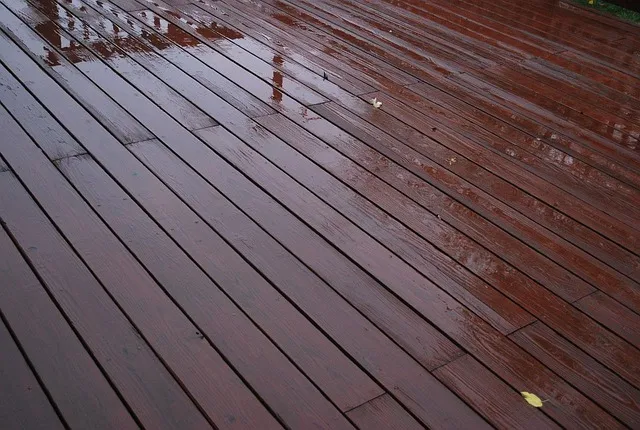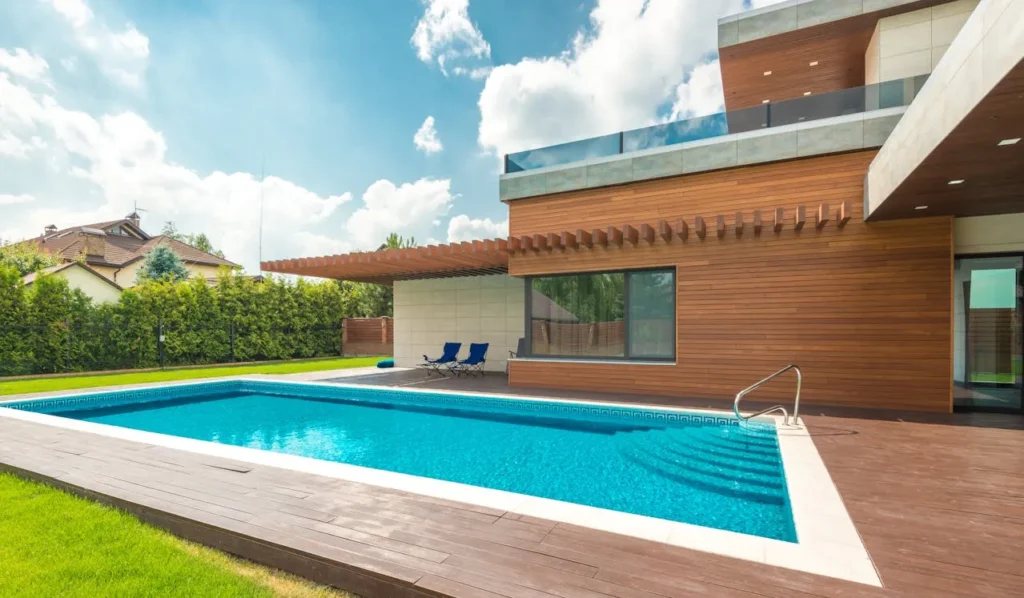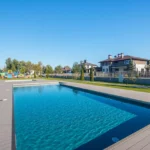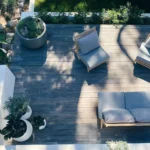Composite decking is known for its durability, low maintenance, and resistance to rot. However, one common concern among homeowners is slipperiness, especially in wet or high-moisture environments like poolside decks or shaded areas. A slippery deck can pose safety hazards, increasing the risk of slips and falls. Fortunately, there are several effective ways to improve traction on your composite deck and enhance safety.
In this article, we’ll explore why composite decks become slippery and provide practical solutions to make your deck safer for everyday use.

1. Why Does Composite Decking Become Slippery?
Although composite decking is designed to be more slip-resistant than traditional wood, certain factors can make it more slippery, including:
- Moisture Accumulation: Water from rain, pool splashes, or humidity can make the surface slick.
- Mold and Algae Growth: Shady and damp areas promote mold, mildew, and algae buildup, which can make the surface slippery.
- Dirt and Debris: A buildup of dust, pollen, and organic matter can reduce traction.
- Smooth Surface Finish: Some WPC decking has a smoother finish, which may reduce grip, especially when wet.
Understanding these factors can help you choose the best approach to improve traction.
2. Regular Cleaning to Prevent Slipperiness
Keeping your deck clean is the first step in maintaining a slip-resistant surface.
How to clean your composite decking:
- Sweep regularly – Remove leaves, dust, and debris to prevent buildup.
- Wash with soapy water – Use mild dish soap and warm water to scrub the surface with a soft-bristle brush.
- Use a mold remover – If you notice mold or algae, apply a composite-safe cleaner and rinse thoroughly.
- Avoid pressure washing at high settings – High-pressure washing can damage the surface; use low pressure if necessary.
* Tip: Cleaning your deck at least once a month can prevent slipperiness caused by dirt and organic buildup.

3. Apply Anti-Slip Coatings and Treatments
Anti-slip coatings add a textured layer to your composite decking, improving traction.
Best Options:
- Anti-Slip Deck Sealers: These sealers contain fine grit or aggregate to provide a textured surface.
- Grip Additives for Paint or Stain: If your WPC deck is paintable, adding a non-slip additive to the coating can increase traction.
- Spray-on Non-Slip Treatments: Easy-to-apply solutions designed for composite decking can enhance grip.
* Tip: Always check if the coating is compatible with your specific WPC decking brand before applying.
4. Install Non-Slip Mats or Grip Strips
For an instant improvement in safety, consider adding non-slip accessories to your deck.
- Rubber or Textured Outdoor Mats: Place them in high-traffic or wet areas for extra grip.
- Grip Strips or Tape: Apply non-slip tape or adhesive strips along steps and frequently used areas.
- Interlocking Deck Tiles: These can provide additional grip and improve aesthetics.
* Tip: Choose UV-resistant mats and strips to ensure long-lasting effectiveness.
5. Improve Drainage and Ventilation
Excess moisture can make your WPC deck slippery, so improving drainage can help.
How to enhance drainage:
- Ensure proper deck slope – Your deck should be slightly sloped to allow water runoff.
- Clean drainage gaps – Keep gaps between boards free from dirt and debris to allow better water flow.
- Use perforated mats – In persistently wet areas, perforated rubber mats can prevent water pooling.
* Tip: Increasing airflow beneath the deck can also help reduce moisture buildup.
6. Choose a Textured or Embossed Composite Decking Surface
If you’re installing a new deck or replacing boards, consider choosing WPC decking with a more textured surface.
- Look for grooved or embossed finishes – These offer better traction compared to smooth surfaces.
- Opt for slip-resistant WPC brands – Some manufacturers offer WPC decking with enhanced slip resistance.
* Tip: If your existing deck is too smooth, adding an anti-slip coating can mimic the texture of slip-resistant boards.

7. Keep Your Deck Dry When Possible
While you can’t control the weather, you can take steps to keep your deck dry.
- Use awnings or pergolas – These can reduce rain exposure in certain areas.
- Wipe down wet areas – After rain or pool use, quickly dry the surface with a mop or towel.
- Avoid overwatering plants – If you have potted plants on your deck, ensure water doesn’t constantly drip onto the surface.
* Tip: If you live in a rainy climate, consider choosing darker-colored WPC boards, as they dry faster in the sun.

Make Your Composite Deck Safer and More Enjoyable
A slippery deck doesn’t have to be a permanent problem. By cleaning regularly, applying anti-slip treatments, and improving drainage, you can create a safer outdoor space for family and guests. Whether you use simple solutions like non-slip mats or invest in anti-slip coatings, these methods will help you enjoy your composite deck with confidence.
By following these tips, you can ensure that your composite deck remains both beautiful and safe all year round! If you want to know more about composite decking, you can also read this full guide: Everything You Need to Know About Composite Decking
Want more smart ideas for using composite materials in your home? Head over to ecobuildhome.com, where you’ll find expert tips, how-to guides, and product comparisons to help you build sustainably and stylishly.

